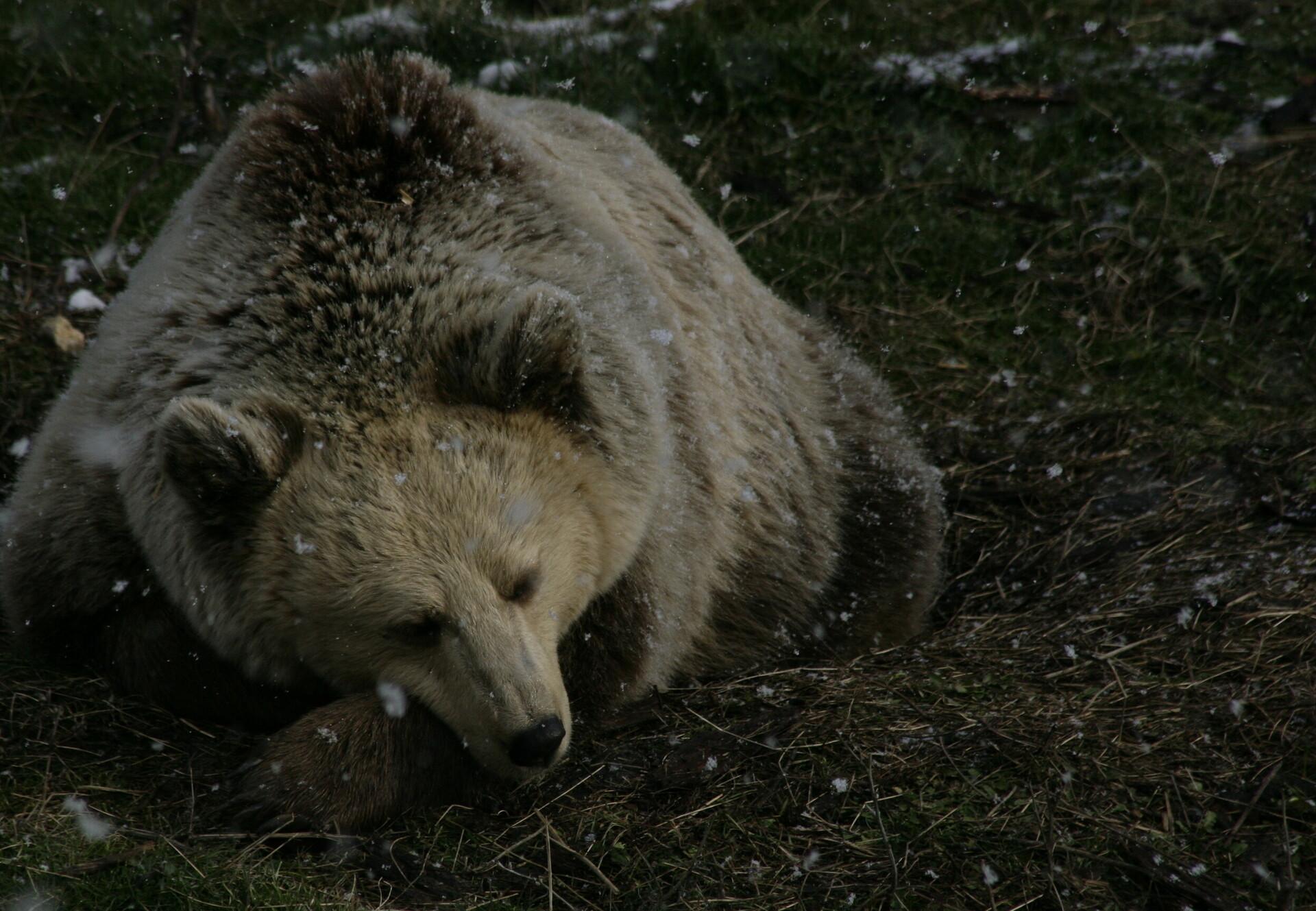
The Brown Bear: Torpor or Hibernation?
How bears doze through the cold season – eating nothing for up to three months
Brown bears enter a winter resting period between October and December. They usually dig a den which they may use for several consecutive years. Natural caves or rock fissures sometimes also serve as retreats. Before the winter sets in, the bears cushion their dens nicely with grass, leaves, ferns, moss and lichen. This cosy hole is ideal for dozing, because brown bears are not 'true' hibernators like, for example, hedgehogs. Although the frequency of their heartbeat and breathing slows down, the bears are easily woken and are able to defend themselves in the case of attack.
Before their winter rest, bears must eat enough to form a decent layer of fat since they lose around a third of their body weight during this sleeping phase. Incidentally, the scientific community is divided about how to describe the bears' resting condition: as winter sleep, winter rest, torpor, hibernation – all these terms are in circulation. But it is always about saving energy during a time of scarce food.
It is often falsely assumed that bears are driven into their dens by the cold. But contrary to us humans, the bear is relatively insensitive to minus degrees, snow and frost. Bears use the rich autumn time when fruits containing plenty of fat and sugar such as nuts, beechnuts, seeds, berries, etc. can be harvested in order to gorge themselves fat. This layer of fat enables their survival in winter, under the condition of reduced energy consumption. For the latter, rest is an important precondition.
Winter dormancy or hibernation?
Bears go into torpor, which should not be confused with the deep hibernation of smaller mammals such as hedgehogs and marmots. During hibernation, the marmot reduces its metabolic rate to a tenth of its normal level: it breathes only once or twice per minute and its heart beats a maximum five times. Its body temperature drops to only three degrees Celcius.
The bear, on the other hand, reduces its circulation, breathing and heartbeat only to a level at which it is able to defend its den at any time. If it were to reduce the temperature of its heavy body, which weighs several hundred kilogrammes, to three degrees Celsius, it would be unable to 'get into gear' without an external energy source. The exact manner in which it manages its energy balance, the shape of its temperature curves and its restricted kidney function – this all largely remains a mystery.
These questions are of great interest to human medicine. Taking into account that bears lie around for weeks without suffering a breakdown of bone or muscle mass, nor does the skin develop sores, a link can be made to one of the biggest challenges faced by geriatric medicine. And while kidney patients often need life-long dialysis, the bear can seemingly switch its kidney function 'on and off' when necessary.
The Bear: An Artist of Adaptation

Pregnant polar bears dig a den in the snow in November. They bury themselves there for the whole winter without hunting, and give birth to their young in the spring. During this time, their heart beat drops to an average eight beats per minute.
Each bear is different
Questions often crop up concerning the basic parameters of the winter resting phase, for example: how long do bears sleep? How much do they cool down? How much weight do they put on beforehand, and so on. The only reliable thing that can be said here is: bears are extraordinary individualists! This means that no one bear behaves like another, just as each winter is different. Like with all biological phenomena, a high degree of flexibility is involved. And that is vital because in changing environmental conditions, inflexibility has often led to the extinction of animal species.
In isolated cases, bears do not enter torpor at all – sometimes because they are good hunters and have specialised in capturing old, weak or injured prey in the winter forest. Or because they have learnt to access alternative sources of food such as deer feeding stations, winter fields or waste produced by humans. In the same way, there are no fixed times for the start and end of the winter resting period. Bears sometimes become active during short, warm periods and dig for roots in the frost-free forest floor, then disappear back into the den with the new onset of winter.
Winter dormancy in captivity
The winter behaviour of bears in captivity is often used as a yardstick to measure whether an enclosure is well suited to the species. Many animal parks practically compete in proving the quality of their enclosures on the basis of how much and how long the bears sleep. Although there is some justification for this approach, the lack of a winter resting phase is no sure indicator for inadequate keeping conditions.
There is no form of keeping bears in captivity that equals the natural, a wild life of a bear – to come close, an enclosure would have to cover around one hundred hectares per bear. Some bears tolerate a fenced habitat better than others. Many, due to deficits in their early development, have developed such strong behavioural defects that these dominate their lives almost completely.
Freedom of choice is decisive: if wild animals have to live in captivity, it is important that they are provided with space for self-determination.
Note: Any advertisements that may appear during the viewing of this video are unrelated to FOUR PAWS. We assume no liability for this content.



